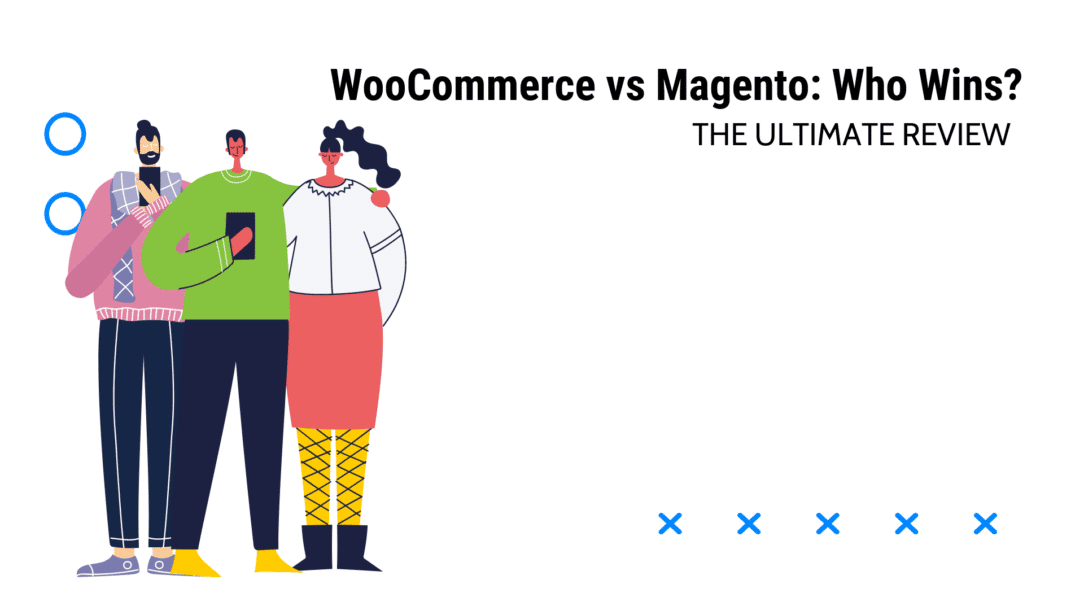According to Statista, worldwide eCommerce sales will reach $6388 billion by 2024 which stands at $5424. The world is going to witness a huge spike in just two years. There is no doubt that eCommerce is on the rise, and it’s not going to go anywhere. Businesses are flourishing with e-commerce. New start-ups are joining e-commerce with rapid speed. More and more brands are moving their sales to eCommerce in order to reach more customers, reduce operational costs, and have a better brand image.
If you are starting an eCommerce store, the first thing you will have to decide is what platform your store should be based on. There are numerous options out there, but among the most popular is WooCommerce vs. Magento.
One of the most commonly asked questions in this regard is:
WooCommerce vs. Magento – which one is right for me?
Both WooCommerce and Magento are fantastic platforms, which serve different needs – one might be right for you, or it might not. They have specific functions, strengths, and weaknesses – and while they provide a similar result, the way you go about achieving that is vastly different. The best thing to do is first recognize your needs and see which of the two is a better fit.
So, let’s start from scratch and find out exactly what Magento is and what WooCommerce is. We will look at their key features, who is the best fit for you, and conclude by answering – WooCommerce vs. Magento – who wins?
But first thing first.
What is WooCommerce?

WooCommerce Homepage
WooCommerce is, at its core, an open-source plugin for WordPress that allows you to set up your own e-commerce website on top of WordPress. You can sell physical products, digital downloads, manage shipping, coupons, and discounts – basically everything you need to run an e-commerce website. WooCommerce makes it extremely easy to set up shops using WordPress’s user-friendly interface and its vast WordPress community to get help with anything you can’t figure out yourself.
What is Magento?
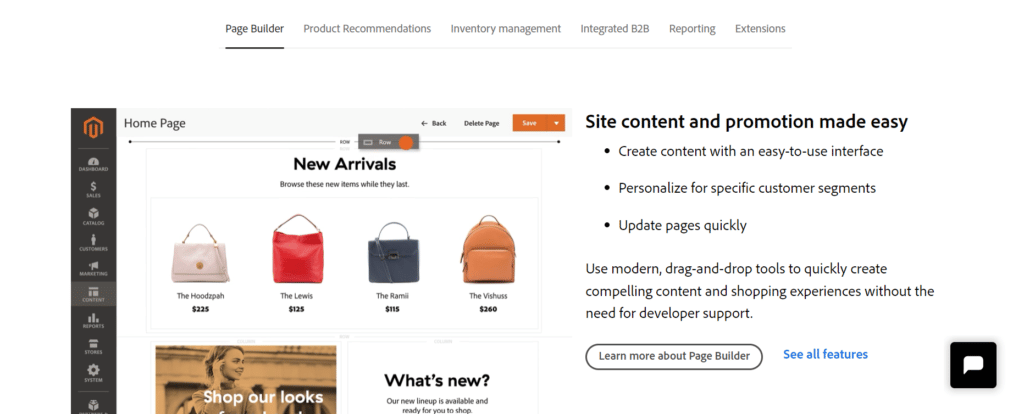
Magento Homepage
Magento is a powerful, versatile e-commerce platform written in PHP that allows you to build your own online store. It’s very flexible and scalable and has a huge community behind it.
There are some trade-offs with Magento, though – while it’s very flexible, you need to have fairly advanced knowledge of web development to set it up, and if you want to customize anything, you need to code. Magento also has a significant learning curve to master. Now that you know the basics of each plugin let’s take a look at their key differences. If you want a full-fledged eCommerce platform with good features and support, Magento is the best.
If you need a simple and easy-to-use platform for eCommerce website building with a user-friendly interface, Woocommerce is a better option. But we can’t judge the platforms with one-liners. Let’s go for an in-depth review of each platform.
Also read: Shopify vs. Wix: Which Is Better for Ecommerce in 2022?
Main Differences between Magento and WooCommerce
If we look back to 2020, Magneto had more than 170,000 websites built with it – it makes a total of 1.4% of websites available on the internet today. Woocommerce is the most powerful and perhaps popular CMS and hosts almost 28 million websites. Magneto is explicitly designed for professionals and has a very steep learning curve. The world’s most famous names like Olympus, ASUS, and Ford employ Magneto’s services.

Asus Store using Magento
WooCommerce, on the other hand, is more affordable, easy to use, and is very flexible. It transforms your random website into a store.
Some popular stores are hosted on Woocommerce plugins like Pickle, Earthbound, and Root Science.

Earthbound Petstore using WooCommerce
The Main Difference!
While both are open source, Magneto is a more complicated platform that takes time to master. It’s very difficult for beginners to learn, and even for experienced coders, it can be challenging to set up. WooCommerce, on the other hand, is beginner-friendly and easy to use. There is a comprehensive community behind it if you get stuck, and the plugin itself is backed by Automattic – the company that owns WordPress.
In short, if you are a significant brand that would need high customization, Magneto’s services would be the best fit, and you might need to hire developers to customize it for you. Otherwise, WooCommerce is a more beginner-friendly solution that provides high-end results.
Now, let’s take a look at the features and functionality of both these platforms to find out who wins WooCommerce or Magento?
This comprehensive table about the features of each platform will help you understand which one suits you the most.
| WooCommerce | Magento | |
| Pricing | WooCommerce is an open-source platform and has reasonable pricing | Magento is also an open-source platform but has high pricing |
| Performance and Speed | High availability but average response time | Almost same availability but has a better response time |
| Plugins and Extensions | 50k or more extensions; some are free and some are paid | Magento offers up to 1900 free extensions but the difference is their paid extensions are costly |
| Inventory Management | Unlimited products inventory but a weaker system. WooCommerce doesn’t handle complex inventory and multi-vendor products | Unlimited products and has a powerful inventory system with sufficient complex products handling |
| Themes and Templates | 20 built-in themes and you can buy premium themes at $35 to $40 each | Only 2 inbuilt themes but you can purchase new themes at $17 each. Requires coding to use this feature |
| Security | WooCommerce needs a manual PCI-compliant process.
You need a reliable hosting package and a good security plugin |
Magento has automatically PCI-compliant.
More advanced and detailed security features. 24/7 monitoring |
| Multi-language Support | Magento has built-in support for international customers and multi-currency support | With WooCommerce, you need a third-party plugin like WPML to support multi-language different currencies |
| SEO | It offers advanced SEO capabilities | It has limited SEO capabilities |
| Customer Support | No official 24/7 support
It can’t support in emergency situations |
Only active user community. |
| Transactions and Payment | No transaction fee
Supports all major payment gateways 6 payment methods |
No transaction fee
Supports all major payment gateways Four payment methods |
| Ease of Use | User-friendly interface
Easy installation |
Complex installation system |
WooCommerce vs. Magento: Detailed Comparison!
WooCommerce and Magneto both have their own pros and cons, so let’s compare them in detail.
Pricing: Who is the Winner?
The first thing we look at when it comes to choosing e-commerce platforms is pricing. You need to understand the future needs of your store and accordingly choose the platform.
What is the Pricing of Woocommerce?
WooCommerce is an open-source plugin. So, the basic functionalities cost around $10 for all users. However, you need to pay an extra amount for a domain name, hosting, SSL certificates, and more. Themes, extensions, and different plugins can start at $25, and new themes and designs cost around $50 to 100 on average. A larger store would pay around $1000 a year on average. (source Website Builder Expert)
In short, the essential features for WooCommerce are very reasonable, but when you start adding more and more features, they can be costly.
What’s the Advantage?
If you are a new e-commerce store that doesn’t need that many features, then you will find WooCommerce easier to use than Magneto because it offers the basic functionalities for free.
What is the Disadvantage?
If your brand comes into the spotlight and you get high traffic to your store, you have to spend a lot on premium licenses and extensions. While WooCommerce has a big community, it is not as large as the Magneto community.
What is the Pricing of Magneto?
Magento has three versions.
- Magento Community: This version is similar to WooCommerce as free and open-source. However, it doesn’t have as many features as the other two versions.
- Magento Enterprise: This is a paid version for major and complex businesses, and we can say that it’s somewhere between $2000 – $3000. It offers the most features and comes with frequent updates that can be hard to manage.
- Magento Enterprise Cloud: This one is equal to the Magento Enterprise, but the benefit is, it’s hosted on the cloud.
The first version is for any business. You can download and install it without any hassle. You can also add and remove extensions if you need to. But you will need to purchase paid extensions and plugins that can cost around $500 to $2000.
The second version – Magento Enterprise – is usually purchased by large and medium-sized businesses that need a lot of features. Its price can reach up to $100,000 depending on the store’s GSR (Gross Sales Revenue).
The third version – Magento Enterprise Cloud – is meant for large businesses with high GSR. It costs around $10,000 to $20,000 a year.
What’s the Advantage?
If you are a large brand that needs a lot of features and you plan to expand your services in the future, Magneto Enterprise Cloud would be the best option for your needs.
What’s the Disadvantage?
Magento is way costly for a normal-sized business, but its community is much larger. So, if you are looking to save costs, WooCommerce is the right option.
Performance and Speed: Who is the Winner?
This is another crucial factor for an e-commerce store. Performance and speed can make or break your business. If users can’t reach your store or search for products becomes a chore, you will lose them.
So, Which One is Faster?
Performance and Speed of Woocommerce
The following visuals can give you a clear idea about the speed and performance of both platforms.
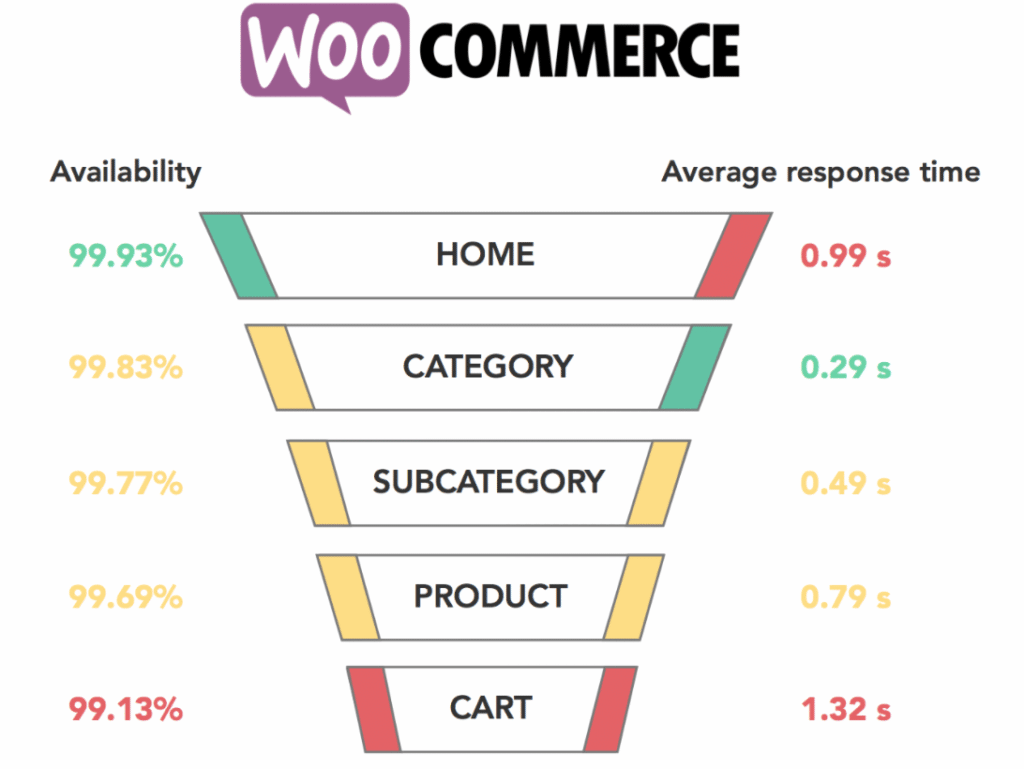
Load Times WooCommerce (source blog.quanta.io)
Magento Stats:
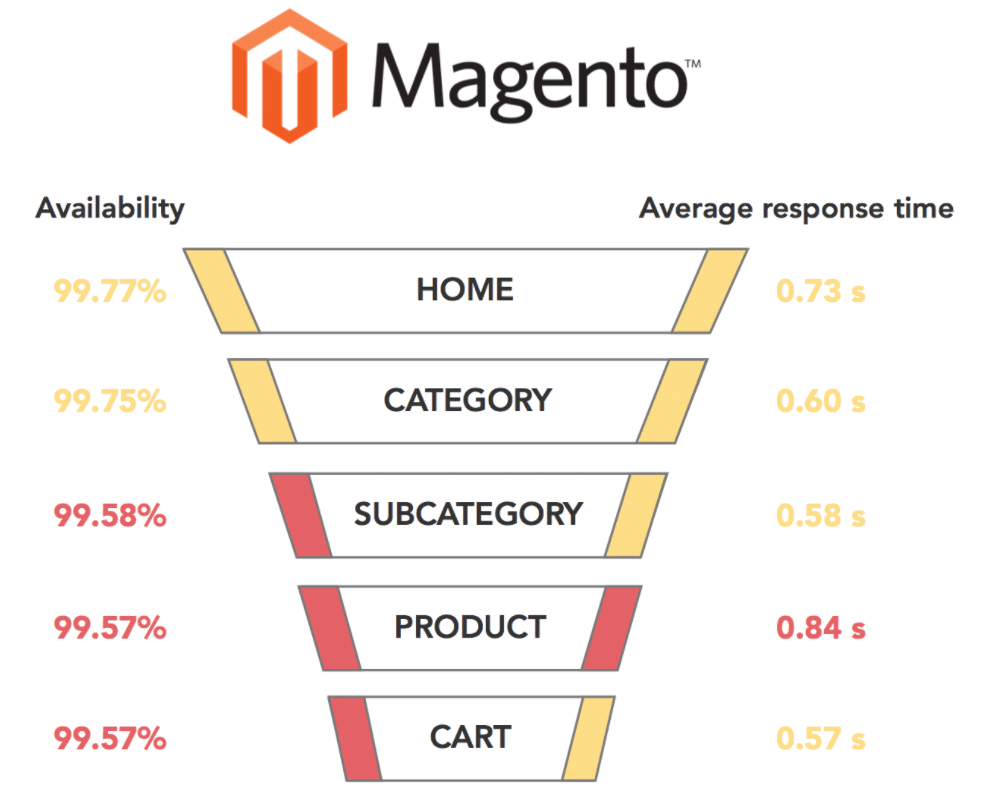
Load Times Magento (source blog.quanta.io)
So, with these stats, you can see both the platforms have high availability. However, Woocommerce is behind in terms of average response time.
Performance and Speed of Woocommerce
Woocommerce comes in a close second in terms of average response time, but it has much better availability. The platform has 99.93% availability which means your site will be accessible at any time. Magento has an availability of 99.77%, which is slightly low than Woocommerce, but it has a slightly better response time.
So, Which One is Faster?
WooCommerce takes the lead in terms of speed and performance, which is crucial for e-commerce stores. The availability of both platforms is high, but when it comes to speed and performance, Woocommerce takes the lead.
How can you improve the speed and performance of your e-commerce store?
The following steps can be taken to improve the speed and performance of your e-commerce store:
1) Installing a Cache Plugin: A cache plugin can help you to improve performance because it gets rid of all the unnecessary data stored by your site. It makes the site load faster. Installing a cache plugin can work wonders for your e-commerce store.
2) Optimizing Images: Make sure to compress your images down to a standard size so that they don’t take a lot of time to load.
3) Optimizing Database: Optimizing your e-commerce site’s database can also help to improve speed and performance.
4) Using a Content Delivery Network: A Content Delivery Network (CDN) is like an insurance policy against any website problem or downtime. It acts as a backup host for your site, and if there is any issue with the main host, it automatically redirects your site’s visitors to the CDN, which serves as a secondary host.
The developers at Magento always expect and go to the best of their abilities to make an error-proof platform. Magento 2.0 has high availability and performance. In this aspect, Magento 2.0 takes the lead in terms of speed and performance over Woocommerce.
Plugins and Extensions: Which One is More Extensible?
WooCommerce takes the lead here! It provides you with 55,000 or more free plugins and extensions, which can extend your site’s functionalities. You can find a plugin for every service, whether it is store management, inventory management, enhancement, email marketing, shipping management, or even taxes.

WooCommerce Extensions Store
On the other hand, Magento provides you with up to 6000 extensions and plugins. Some of them are free, and others are third-party paid extensions. They have a vast majority of plugins, being a paid platform. Your accounting, finance, marketing, management, inventory, and other business-related issues can be resolved with these free and paid extensions. So, both the platforms have the best plugins and extensions, but it comes down to your store. How big it is, how much scale your business will reach, and how much you would like to invest in terms of money, time, and effort.
Inventory Management: Who is the Winner?
Both the platforms allow adding as many items to your inventory as you want. Moreover, they will enable you to add a specific number of products on which your site will be billed.
However, there are some points where both platforms differ.
WooCommerce
Woocommerce has a weaker inventory management system as compared to Magento. If you are running a multi-store, i.e., you have different niche-related products, you need to use the paid plugin to manage inventory.
Magento
Magento has a stronger inventory management system. Magento has a feature called ‘Auto-merge,’ which helps you control the number of products based on your plan. You can handle the complex store hierarchy within a store in Magento.
So, which one is better when it comes to inventory management? It totally depends on your business. Magento is a complete solution out of the box. So, it is preferred when you have a significant number of products, and you don’t want to struggle with managing multiple stores.
Themes and Templates: Who is the Winner?
Themes and templates are among the most critical aspects of your e-commerce store. This is what customer sees first on your site, and before they buy, so you want it to be the best one. The latest research found that 42% of consumers hesitate to buy from an e-commerce store if they don’t like the theme.
So, which platform has the best themes and templates?
WooCommerce
Well, this point goes to Woocommerce. It offers more than 20 built-in themes, and you can even purchase independent themes designed by professional designers. They cost you $35 to $40 each. And the best thing is you can customize Woocommerce themes and designs. In these 20 built-in themes, you can get Woocmerce popular storefront theme.

WooCommerce Theme Marketplace
Magento:
Magento, on the other hand, has only two built-in themes. However, they have some benefits that you may not find in Woocommerce. You can create your own theme from scratch with Magento, and you can purchase new themes at $17 each. However, you must know coding to use this feature. Between the two built-in themes, Magento also offers their popular Luma theme.
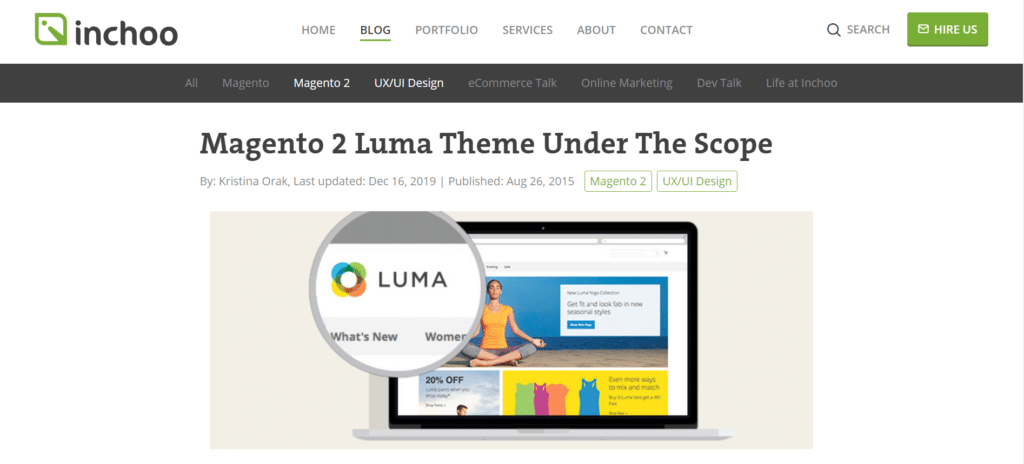
Magento Theme Marketplace
So, Woocommerce has comparatively better themes and templates.
When you are doing customization, Woocommerce has the upper hand as compared to Magento. In Woocommerce, they have a WordPress plugin to customize your store, but for Magento, you need to know to code. However, when it comes to code-level customization, Magento has the upper hand as compared to WooCommerce.
So, Woocommerce themes and templates offer more than Magento, but technical users can take advantage of Magento customization features. But you can always purchase new themes for Woocomerce and Magento based on your needs.
Security and Performance: Who is the Winner?
Did you know 51% of consumers will leave your website if you don’t have an SSL Certificate? SSL Certificate encrypts customer payment details and gives a sense of security to your customers. It also shows that you care about their privacy, and they’ll be more likely to buy from you. Which platform is better when it comes to security and performance? Magento is the winner here as they offer more advanced and detailed security features. They are PCI-compliant and regularly release new security patches to keep their customers safe. Since they are in partnership with Siteground, you get more advanced security features with a 24/7 monitor and free intrusion blocker to help your site stay safe. Magento 2 also has built-in two-factor authentication to protect users when accessing the Magento Admin panel.
WooCommerce
Since your store on Woocommerce is self-hosted, you will need a reliable hosting package and a good security plugin. You need manual efforts to make your store PCI-complaint while with Magento, it’s an automatic process. You also need an SSL certificate from a third-party plugin. So, Magento has the upper hand in this section because they have a dedicated security team that tests and rechecks their platform before releasing, unlike Woocommerce.
Though both platforms are self-hosted, and you need to keep a good check on them to keep them secure, Magento is more reliable as compared to Woocommerce.
Multi-language Support: Who is the Winner?
In e-commerce, the international market is a huge opportunity to increase your sales. In fact, most online sales are done by international buyers from different countries. So, which platform is better when it comes to multi-language support? Magento has built-in support for international customers, which means you do not need any plugin to support international languages and currencies. On Woocommerce, you will need a third-party plugin like WPML to support multi-language different currencies.
So, Magento is the winner here because you do not need to buy third-party plugins to support multi-language and different currencies.
SEO Capabilities of Both Platforms: Who is the Winner?
Magento is always known to offer advanced SEO capabilities. You will get more functionalities with Magento than Woocommerce. For example, you can use Google Shopping campaigns to promote your product variations using images instead of just text. With Magento, you can also optimize your product titles to rank higher in search engines. You can also create automatic XML sitemaps to increase your search engine rankings. Woocommerce has limited SEO capabilities. So, you will need a separate plugin to boost your store’s SEO capabilities.
So, Magento is the winner here as they offer more advanced SEO capabilities than Woocommerce.
Customer Support: Who is the Winner?
Magento offers an official support forum. You can get help from Magento experts or other users on this forum. You can even use third-party developers to help you handle customer queries and provide them quick and satisfactory service. If you are on Magento Cloud edition, you get optimal support services from them as they have a dedicated support team for Magento cloud customers.

Magento Community Hub
On the other hand, WooCommerce doesn’t have a robust support system, and you need paid plugins to help you with your customer queries. WooCommerce is purely based on the community, and there is no official platform to help customers.
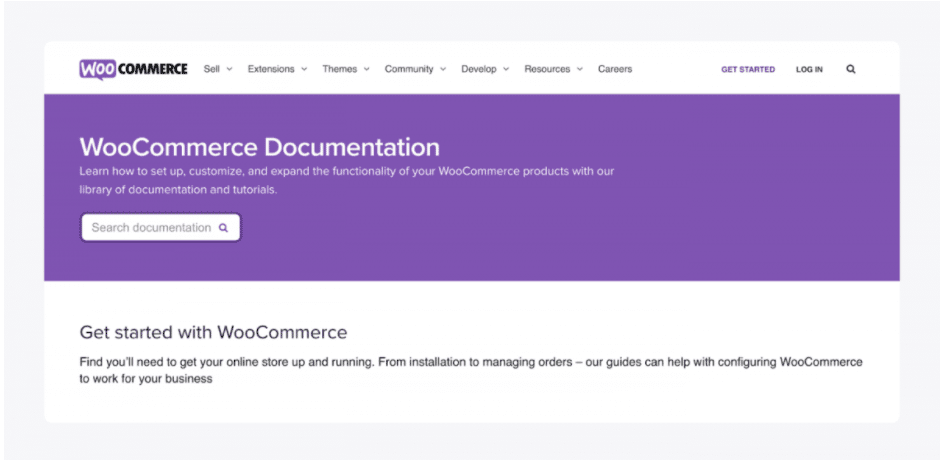
WooCommerce Docs
None of the platforms have their own customer support that you can contact in case of an emergency. That’s a negative for both. Since e-commerce stores heavily depend on customer service, they rely on AI-powered chatbots to answer customer queries. AI-powered chatbots not only answer your customer queries but also reduce the load on live support systems. That’s where Clepher helps e-commerce stores provide quick and effective support. Clepher partners with stores and gives them AI-bots service to handle their customer queries.
Though both the platforms provide essential customer support, Magento is ahead in this section because they have a feature-rich customer support system and you get paid support services from Magento. But when it comes to utilizing artificial intelligence to scale chatbots for online businesses, you can rely on Clever messenger.
Transactions and Payment Gateways: Who is the Winner?
So, that’s another most important thing when it comes to e-commerce. If you are available on multiple platforms, your buyers will automatically place orders from where they can get better deals. Currently, there are plenty of options for buying and selling online across the world. In fact, your customers can buy from different websites as well.
So, the question is, how will your customers pay?

Payment Options
At present, Magento doesn’t charge any transaction fee and supports all major payment gateways. You can integrate your store with any popular payment gateway like Stripe, PayPal, Braintree, etc., without any hassles. Magento provides six payment methods: online card payment, check order, COD, bank transfer, purchase order, and zero subtotal check out. However, Apple Pay isn’t supported. With WooCommerce, you can integrate with some popular payment gateways like PayPal, Braintree, and Woocommerce Payments. You can pay with four methods: bank transfer, COD, online card payments, and check out.
The benefit of Woocommerce is it supports Apple Pay and doesn’t charge any transaction fee.
So, Magento has an advantage over WooCommerce regarding transaction and payment gateways. They provide six gateways and provide more options for payments and support online card payment, COD, check order, etc.
Ease of Use: Who is the Winner?
Ease of use is important when it comes to e-commerce platforms. While some users may want more features, others prefer clean and simple interfaces.
Magento: Magento provides a user-friendly interface. However, you need to learn coding to custom designs using Magento’s drag and drop editor.
You can’t easily customize your site logo and other aspects. Magento provides a feature-rich backend panel for administrators to manage orders, customer information, sales, etc. They also have better SEO features, analytics tools, better inventory management, and also you can sell multi-vendor products.
WooCommerce: WooCommerce is best for newbies. Since WordPress supports it, installation is very easy. You can easily install it on your hosting account with some simple steps. WooCommerce isn’t complex at all and easy to manage, update your products, etc.
However, multiple selling isn’t easy with Woocommerce, and you need additional plugins to manage it. However, WooCommerce is suitable for small and medium-sized stores because they provide a user-friendly interface. They also have a small learning curve, so it’s easy to learn WooCommerce.
WooCommerce vs. Magento: Which eCommerce platform should I use?
Well, the final decision is yours. If you are good with coding and need more features, go with Magento. But if you don’t know too much about coding and want a simple and easy-to-use platform for e-commerce website building, Woocommerce fits your needs perfectly. Magento has an advantage over WooCommerce regarding transaction and payment gateways. They provide six gateways and offer more options for payments and support online card payment, COD, check order, etc.
If you plan to sell multi-vendor products, Magento is the best. They also have better SEO features, analytics tools, better inventory management, and also you can sell multi-vendor products. However, if you aren’t a tech-savvy person, WooCommerce is a better option for you. They provide a user-friendly interface, and it’s easy to create custom designs using Magento’s drag and drop editor. You can easily customize your site logo and other aspects.
WooCommerce also provides a feature-rich backend panel for administrators to manage orders, customer information, sales, etc.
With that hope you liked this write up, let us know in the comments what you think!
Related Posts

